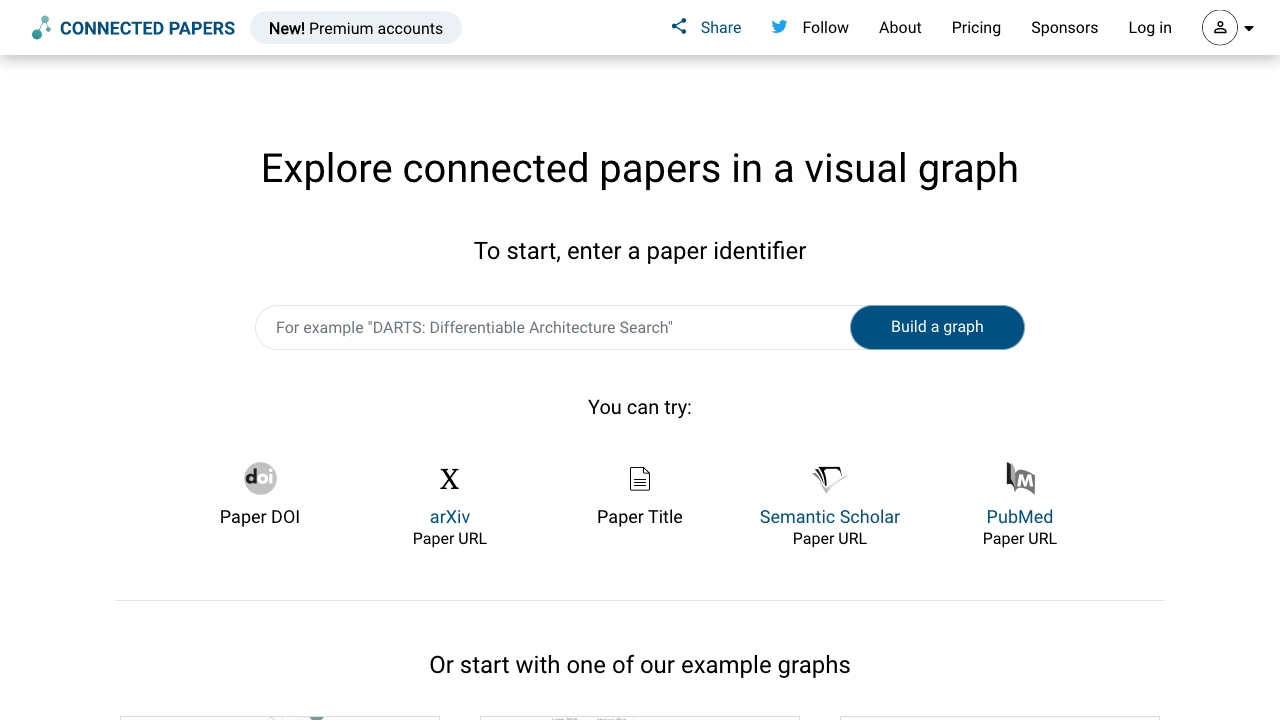- Home
- AI Knowledge Graph
- Connected Papers

Connected Papers
Open Website-
Tool Introduction:Explore digital intimacy with AI companions; scenes, RP, and visuals.
-
Inclusion Date:Oct 21, 2025
-
Social Media & Email:
Tool Information
What is Connected Papers AI
Connected Papers AI is a visual literature discovery tool that helps researchers and applied scientists map a research field and quickly surface relevant academic papers. Built on the expansive Semantic Scholar corpus, it generates an interactive graph that highlights closely related works using signals such as co-citation and bibliographic coupling. With bi-directional exploration, you can trace both prior art and derivative research, identify influential papers, and understand relationships across subdomains. It reduces blind spots in literature reviews and accelerates onboarding to new topics.
Connected Papers AI Key Features
- Interactive research graph: Visualize a literature landscape and see how papers are connected through shared references and readership patterns.
- Bi-directional exploration: Discover both prior and derivative works to follow the evolution of ideas backward and forward.
- Field overview and clustering: Spot clusters, subtopics, and bridges between areas to understand domain structure at a glance.
- Relevance and influence cues: Surface popular or foundational papers to anchor a literature review.
- Paper detail context: Open nodes to view abstracts and metadata, then jump out to source pages for full texts where available.
- Refinement tools: Start from one or multiple seeds to focus the graph and triangulate related literature.
- Saving and sharing: Keep graphs for later, share them with collaborators, or export snapshots for documentation.
Who Should Use Connected Papers AI
Connected Papers AI is well suited for graduate students, principal investigators, data scientists, and R&D teams who need a fast overview of a topic. It helps librarians and information specialists support scoping reviews, and benefits practitioners entering adjacent domains who must ensure they do not miss key related works. Product and innovation teams can use it to survey research trends and trace foundational methods before prototyping.
How to Use Connected Papers AI
- Choose a seed paper by entering a title, DOI, or author that represents your topic of interest.
- Generate the graph to visualize related works based on co-citation and bibliographic coupling signals.
- Explore nodes: hover to preview, open details, and inspect clusters and distances between papers.
- Use bi-directional exploration to view prior art and derivative works to map the development of the field.
- Identify influential or bridging papers, then open source pages to read full texts where available.
- Save or share the graph, and create a reading list to guide your literature review workflow.
Connected Papers AI Industry Use Cases
In biomedicine, teams can rapidly map studies around a biomarker to find mechanistic and clinical evidence. In machine learning, researchers can trace families of architectures and training techniques and discover lesser-known variants. Materials science groups can connect synthesis, characterization, and property papers to spot gaps. In HCI and education research, practitioners can identify cross-disciplinary links that inform study design and evaluation methods.
Connected Papers AI Pricing
Connected Papers AI offers access for literature exploration, with optional paid upgrades that expand usage limits and capabilities. Plan details and availability may change over time, so consult the official pricing page for the most current information.
Connected Papers AI Pros and Cons
Pros:
- Provides a fast, visual overview of a research landscape.
- Bi-directional exploration reduces the risk of missing key prior or derivative works.
- Leverages a large, cross-domain database from Semantic Scholar.
- Highlights influential and bridging papers for efficient review.
- Helps newcomers quickly understand subtopics and relationships.
Cons:
- Coverage depends on external indexing; some niche or very new papers may be missing.
- Graph proximity reflects similarity, not a strict citation lineage, which may confuse novices.
- Still requires critical reading and manual validation for comprehensive reviews.
- Free-tier usage limits and advanced export/integration options may be constrained.
Connected Papers AI FAQs
-
Is Connected Papers a citation tree?
No. It visualizes similarity using co-citation and bibliographic coupling rather than a simple parent-child citation timeline.
-
Where does the data come from?
It leverages the Semantic Scholar database, which aggregates hundreds of millions of papers across scientific fields.
-
How do I pick a good seed paper?
Start with a representative, well-cited paper in your area. Using two or three strong seeds can triangulate the graph for better coverage.
-
Can it find very recent or niche papers?
Yes, but visibility may be limited if citations are sparse or indexing is delayed. Supplement with additional seeds and manual searches.
-
Is it suitable for systematic reviews?
It is excellent for scoping and discovery, but it should complement—not replace—formal search protocols and screening criteria.
-
What is the difference between prior and derivative works?
Prior works precede and inform your seed topic; derivative works build on or are influenced by it, showing forward development.

